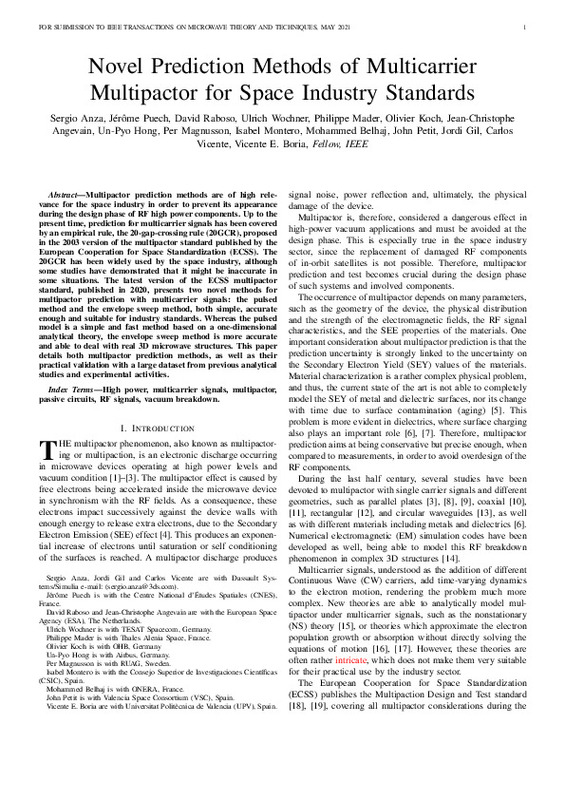Anza, S.; Puech, J.; Raboso, D.; Wochner, U.; Mader, P.; Koch, O.; Angevain, J.... (2022). Novel Prediction Methods of Multicarrier Multipactor for Space Industry Standards. IEEE Transactions on Microwave Theory and Techniques. 70(1):670-684. https://doi.org/10.1109/TMTT.2021.3120095
Por favor, use este identificador para citar o enlazar este ítem: http://hdl.handle.net/10251/200797
|
Título:
|
Novel Prediction Methods of Multicarrier Multipactor for Space Industry Standards
|
|
Autor:
|
Anza, Sergio
Puech, Jerome
Raboso, David
Wochner, Ulrich
Mader, Philippe
Koch, Olivier
Angevain, Jean-Christophe
Hong, Un-Pyo
Magnusson, Per
Montero, Isabel
Belhaj, Mohamed
Petit, John
Gil, Jordi
Vicente, Carlos

 Boria Esbert, Vicente Enrique
Boria Esbert, Vicente Enrique
|
|
Entidad UPV:
|
Universitat Politècnica de València. Área de la Ciudad Politécnica de la Innovación - Àrea de la Ciutat Politècnica de la Innovació
Universitat Politècnica de València. Escuela Técnica Superior de Ingenieros de Telecomunicación - Escola Tècnica Superior d'Enginyers de Telecomunicació
|
|
Fecha difusión:
|
|
|
Resumen:
|
[EN] Multipactor prediction methods are of high relevance for the space industry in order to prevent its appearance during the design phase of RF high-power components. Up to the present time, prediction for multicarrier ...[+]
[EN] Multipactor prediction methods are of high relevance for the space industry in order to prevent its appearance during the design phase of RF high-power components. Up to the present time, prediction for multicarrier signals has been covered by an empirical rule, the 20-gap-crossing rule (20GCR), proposed in the 2003 version of the multipactor standard published by the European Cooperation for Space Standardization (ECSS). The 20GCR has been widely used by the space industry, although some studies have demonstrated that it might be inaccurate in some situations. The latest version of the ECSS multipactor standard, published in 2020, presents two novel methods for multipactor prediction with multicarrier signals: the pulsed method and the envelope sweep (ES) method, both simple, accurate enough, and suitable for industry standards. While the pulsed model is a simple and fast method based on a 1-D analytical theory, the ES method is more accurate and able to deal with real 3-D microwave structures. This article details both multipactor prediction methods, as well as their practical validation with a large dataset from previous analytical studies and experimental activities.
[-]
|
|
Palabras clave:
|
Standards
,
Prediction methods
,
Industries
,
Radio frequency
,
Discharges (electric)
,
Microwave theory and techniques
,
Geometry
,
High-power microwave systems
,
Multicarrier signals
,
Multipactor
,
Passive circuits
,
RF signals
,
Vacuum breakdown
|
|
Derechos de uso:
|
Reserva de todos los derechos
|
|
Fuente:
|
IEEE Transactions on Microwave Theory and Techniques. (issn:
0018-9480
)
|
|
DOI:
|
10.1109/TMTT.2021.3120095
|
|
Editorial:
|
Institute of Electrical and Electronics Engineers
|
|
Versión del editor:
|
https://doi.org/10.1109/TMTT.2021.3120095
|
|
Código del Proyecto:
|
info:eu-repo/grantAgreement/AEI/Plan Estatal de Investigación Científica y Técnica y de Innovación 2017-2020/PID2019-103982RB-C41/ES/DISEÑO AVANZADO DE NUEVOS COMPONENTES DE ALTA FRECUENCIA EN TECNOLOGIAS GUIADAS COMPACTAS PARA FUTUROS SATELITES DE TELECOMUNICACION/
info:eu-repo/grantAgreement/ESA//ECSS-E-ST-20-01C//Update of the ECSS multipactor standard design and test (15 June 2020)/
|
|
Agradecimientos:
|
The authors would like to thank the ESA-ESTEC and ASD-Eurospace for the creation and support of the ECSSE-ST-20-01 working group for the update of the ECSS multipactor standard, which has been the motivation of this work.[+]
The authors would like to thank the ESA-ESTEC and ASD-Eurospace for the creation and support of the ECSSE-ST-20-01 working group for the update of the ECSS multipactor standard, which has been the motivation of this work.
[-]
|
|
Tipo:
|
Artículo
|







![[Cerrado]](/themes/UPV/images/candado.png)


